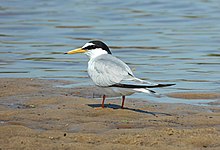
Back Kleinsterretjie Afrikaans Sternula albifrons AN خرشنة صغيرة Arabic Sternula albifrons AST Krepay (Sternula) AVK Sternula albifrons Azerbaijani Крачка малая Byelorussian Белочела рибарка Bulgarian Skravig c'hwiton Breton Xatrac menut comú Catalan
| Little tern | |
|---|---|

| |
| Adult S. a. albifrons in breeding plumage, Lyubikovichi, Ukraine | |
| Scientific classification | |
| Domain: | Eukaryota |
| Kingdom: | Animalia |
| Phylum: | Chordata |
| Class: | Aves |
| Order: | Charadriiformes |
| Family: | Laridae |
| Genus: | Sternula |
| Species: | S. albifrons
|
| Binomial name | |
| Sternula albifrons (Pallas, 1764)
| |

| |
| Range of S. albifrons (Compiled by: BirdLife International and Handbook of the Birds of the World (2019) 2019) Breeding Resident Passage Non-breeding
| |
| Synonyms | |
| |
The little tern (Sternula albifrons) is a seabird of the family Laridae. It was first described by the German naturalist Peter Simon Pallas in 1764 and given the binomial name Sterna albifrons.[2][3][4] It was moved to the genus Sternula when the genus Sterna was restricted to the larger typical terns.[5] The genus name Sternula is a diminutive of Sterna, 'tern', while the specific name albifrons is from Latin albus, 'white', and frons, 'forehead'.[6]
This bird breeds on the coasts and inland waterways of temperate and tropical Europe, Asia, north and west Africa, and eastern Australia. It is strongly migratory, wintering in the subtropical and tropical oceans as far south as South Africa and Australia.
There are four subspecies. The nominate S. a. albifrons occurs in Europe to North Africa and western Asia, S. a. guineae of western Africa, S. a. sinensis in eastern Asia (SE Russia to Japan, SE Asia, Philippines) south to New Guinea and northern Australia, and S. a. placens on the east coast of Australia and Tasmania.[7][8] The former North American subspecies (S. a. antillarum) and Red Sea subspecies S. a. saundersi are now considered to be separate species, the least tern (Sternula antillarum) and Saunders's tern (Sternula saundersi), respectively.
The little tern breeds in colonies on gravel or shingle coasts and islands. It lays two to four eggs on the ground. Like all white terns, it is defensive of its nest and young and will attack intruders.
Like most other white terns, the little tern feeds by plunge-diving for fish, either in coastal saline environments, or inland, along larger rivers. The offering of fish by the male to the female is part of the courtship display.
This is a small tern, 21–25 cm long with a 41–47 cm wingspan. It is not likely to be confused with other species, apart from fairy tern and Saunders's tern, because of its size and white forehead in breeding plumage. Its thin sharp bill is yellow with a black tip and its legs are also yellow. In winter, the forehead is more extensively white, the bill is black and the legs duller. The call is a loud and distinctive creaking noise.
- ^ BirdLife International (2019). "Sternula albifrons". IUCN Red List of Threatened Species. 2019: e.T22694656A155476219. doi:10.2305/IUCN.UK.2018-2.RLTS.T22694656A155476219.en. Retrieved 19 November 2021.
- ^ Peters, James Lee (1934). Check-list of Birds of the World. Volume 2. Vol. 2. Cambridge, Massachusetts: Harvard University Press. p. 340.
- ^ Sherborn, C. Davies (1905). "The new species of birds in Vroeg's catalogue, 1764". Smithsonian Miscellaneous Collections. 47: 332–341 [339]. Includes a transcript of the 1764 text.
- ^ Rookmaaker, L.C.; Pieters, F.F.J.M. (2000). "Birds in the sales catalogue of Adriaan Vroeg (1764) described by Pallas and Vosmaer". Contributions to Zoology. 69 (4): 271–277. doi:10.1163/18759866-06904005.
- ^ Bridge, E. S.; Jones, A. W.; Baker, A. J. (2005). "A phylogenetic framework for the terns (Sternini) inferred from mtDNA sequences: implications for taxonomy and plumage evolution" (PDF). Molecular Phylogenetics and Evolution. 35 (2): 459–469. doi:10.1016/j.ympev.2004.12.010. PMID 15804415. Archived from the original (PDF) on 20 July 2006.
- ^ Jobling, James A (2010). The Helm Dictionary of Scientific Bird Names. London: Christopher Helm. pp. 38, 365. ISBN 978-1-4081-2501-4.
- ^ Gill, F.; Donsker, D.; Rasmussen, P., eds. (January 2024). "Noddies, skimmers, gulls, terns, skuas, auks". IOC World Bird List. v 14.1. Retrieved 26 June 2024.
- ^ Higgins, P.J. & S.J.J.F. Davies (eds) 1996. Handbook of Australian, New Zealand and Antarctic Birds. Volume 3: Snipe to Pigeons. Oxford University Press, Melbourne. ISBN 0-19-553070-5
